Thank you for visiting the COASST blog. We have recently moved to a new web address:
https://coasst.org/news-views/blog/
See you there!

Thank you for visiting the COASST blog. We have recently moved to a new web address:
https://coasst.org/news-views/blog/
See you there!
During the past school year, students from the Health and Science High School in Beaverton, OR created a short documentary about COASST”s beached bird program.
Students traveled to Cannon Beach to interview a few beached bird COASSTers and help out with surveys. They also invited Julia Parrish to visit their classroom to learn more about COASST and the beached bird guide. As participants of PBS Student Reporting Labs, a program created to help students gain a voice in media journalism, the budding documentarians received funding and mentorship to research, film and edit a five minute video. This year’s focus was Citizen Science, which led the students at Beaverton High directly to COASST! Their finished film is showcased along with others on PBS’s website, and exceptional pieces are shown on PBS’s Newshour Program
This video was submitted to a film festival where it won second place in the country for best STEM student report! Congratulations Beaverton students, and thank you to COASSTers Rita, Pete, Pat, and Lori for participating in a day of filming at the beach!
You can view the final video here.
In the excitement about the rise of citizen science, the emphasis has tended to be on the science the citizens (meaning an inhabitant of a place) are helping make possible—how they increasingly facilitate important discoveries, how they help professional scientists and decision makers answer questions at larger scales than might have been possible before. Yet these successes hinge on the experience and contributions of the citizens themselves. In turn, projects like COASST are asking: how can citizen science support the best possible experience?
Participation can happen in many ways. In outdoor environmental citizen science programs, it can include interacting with the environment (in COASST, the beach), or the study objects (birds), or scientists, staff members, and other participants (a team and community). The experience of participation is reflected in the effect that participating has on the participants. For example, how does collecting all those important data make a person feel? How might their reasons to be involved change over time? What do they learn or gain from being involved? And, importantly, to what degree would they feel comfortable having the lens of science turned on them?
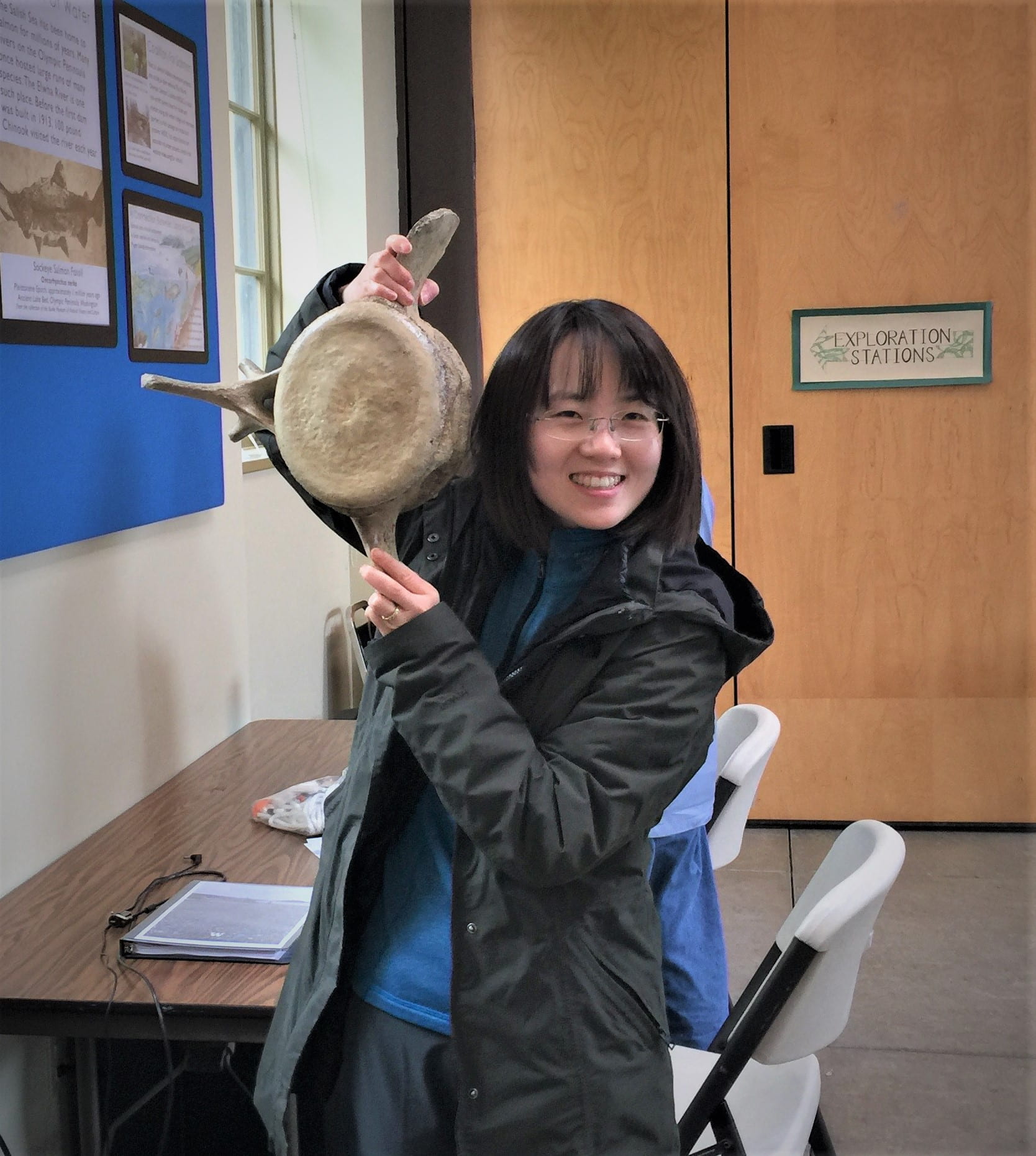
Using her face for scale, Yurong demonstrates the impressive size of a whale vertebrae at the Port Townsend Marine Science Center.
Helping to explore some of these questions is COASST’s resident social scientist, Yurong He. Her research passion lies at the intersection of humans, the natural environment, and technology. Before joining COASST as a postdoc researcher in 2017, Yurong earned her undergraduate degree in psychology from Beijing Forest University, going on to get a master’s degree in cognitive psychology from the Institute of Psychology, Chinese Academy of Sciences. At the same time, she was also a research intern at Microsoft Asia, conducting studies on differing information sharing behaviors among people from China and the United States. “That was when I started to develop an interest in technology,” Yurong says.
Then she came to the U.S. to begin a PhD program at the College of Information Studies at the University of Maryland. It was there she got her first exposure to biodiversity citizen science, combining it with her interest in technology. “My advisor was studying how to use tech to support citizen science,” she says, but as a grad student, she was looking at citizen science from the outside. That changed when she came to COASST. “Here,” she says, “I work from inside the program, so I’m able to take another angle – both are important”.
At COASST, Yurong focuses on the range of lessons that can be extracted from nearly twenty years of surveys for dead birds and, more recently, marine debris. To assess COASST participants’ satisfaction and collect their feedback, her colleagues have sent out questionnaires and interviewed focus groups. Some participants even kept journals for a time, jotting their thoughts and impressions. “All of what the participants have given over and above their beach survey work has been tremendously helpful,” Yurong says. “We want to learn what attracts participants to citizen science in the first place, and what makes them want to stay.”
Through her work, Yurong is gaining insights into how COASST can work better for COASSTers—how it can satisfy their motivations and needs, and empower them to make the difference for the environment. She also identifies themes that can apply to citizen science more broadly. According to SciStarter, there are nearly three thousand formal and informal citizen science programs all over the world, ranging from transcribing old ship’s logs to reconstructing climate (Old Weather), to monitoring water quality, to Project BudBurst, which tracks plant phenology — all projects that might want to know why people initially participate and what keeps them engaged.
“Citizen science is becoming more and more professional and widespread,” says Yurong, who recently attended the third biannual conference of the Citizen Science Association, where she presented some of her findings. “What we learn from COASST goes far beyond our program, and can be applied in a lot of ways.”
Editor’s Note: A closer look at Yurong’s findings will be the subject of the next post!
A little bit more about Yurong. She originally came from China and now lived in Seattle with her husband since 2016. She loves the natural environment, she also enjoys the city life with combination of Asian and Western cultures. In her spare time, she loves to spent time with her family and friends appreciating the beauty of nature, delicious food and coffee. She also loves going to Church and connecting to the local community. She loves listening and singing both contemporary Christian music and classic hymns, and playing drums, like the Cajon to the left, in her church worship team.
by Eric Wagner
Drive along Highway 101 down the Oregon coast to Lincoln County, and a little bit north of the city of Newport you will come to Agate Beach. The beach is an official state recreation site, and according to the Oregon Parks and Recreation Department, it gets a few more than 172,000 visitors each year. Those people can surf if they want, but razor clams are the main attraction. “Diggers, this park’s for you!” the state website proclaims.
For Wendy Williams, 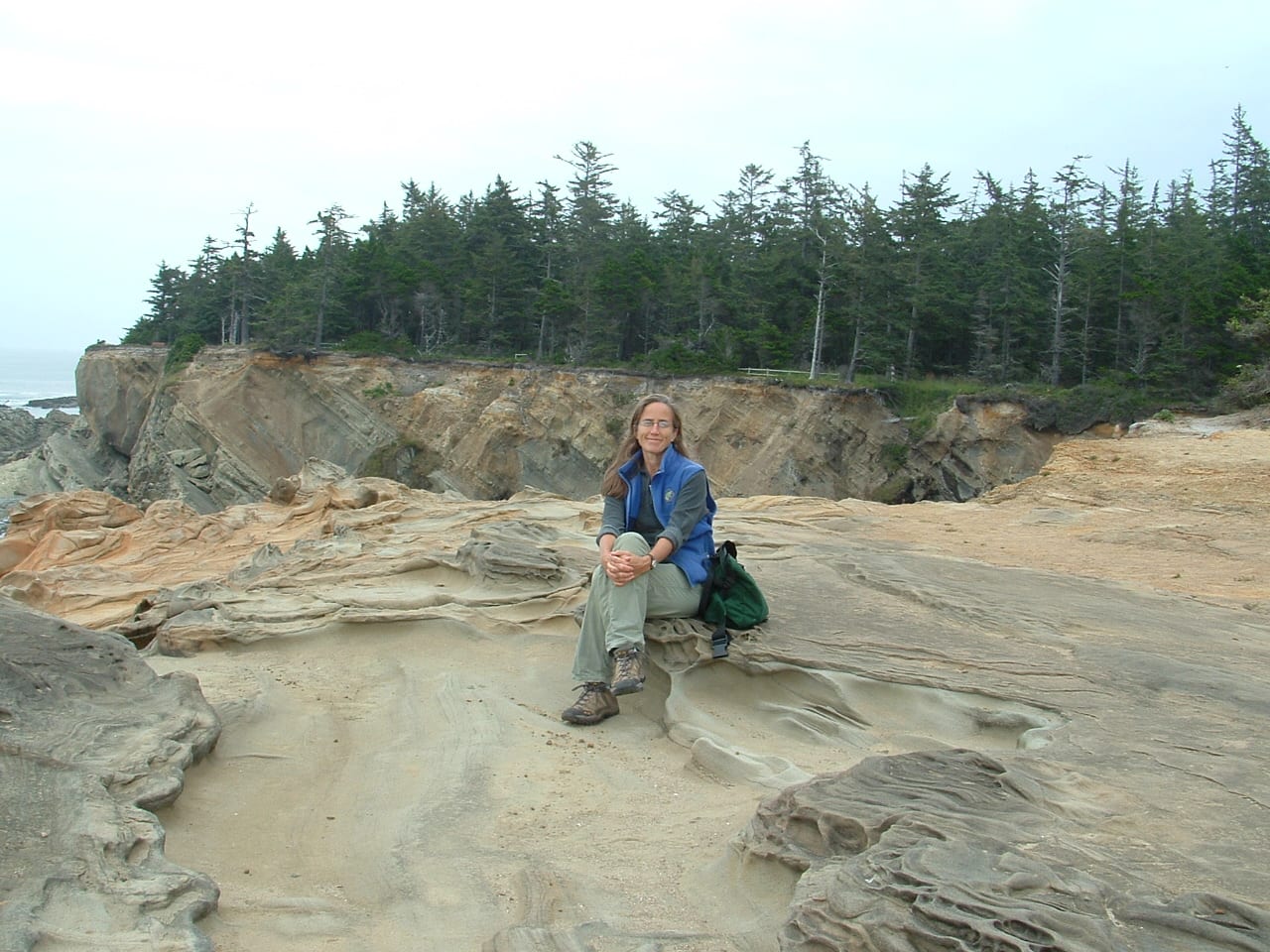 that description doesn’t capture the full appeal of Agate Beach. “It’s basically a big sandy beach, but it’s pretty amazing for a lot of reasons,” she says. The beach is backed by a creek, which has a tendency to wander, its course meandering over the sand with the years. During the summer, when the northwest winds are steady, sand dunes will build up, some of them eight feet tall. “The place is just so dynamic and lively,” she says. “There are a lot of stories in the sands of Agate Beach.”
that description doesn’t capture the full appeal of Agate Beach. “It’s basically a big sandy beach, but it’s pretty amazing for a lot of reasons,” she says. The beach is backed by a creek, which has a tendency to wander, its course meandering over the sand with the years. During the summer, when the northwest winds are steady, sand dunes will build up, some of them eight feet tall. “The place is just so dynamic and lively,” she says. “There are a lot of stories in the sands of Agate Beach.”
Williams knows her share of those stories because she has been walking the beach monthly since 2007 as a volunteer for COASST. In this, she has learned not only Agate’s particular rhythms, but also how they are linked with those of its influential surroundings. Sitting at the beach’s northern end is Yaquina Head, site of a well-known and well-studied murre colony. “I used to find lots of murres, until bald eagles and peregrine falcons started to cut down on fledging success,” she says, of the raptors’ return to the area. “But I’m still always bracing myself: how many chicks am I going to find come August or September because of death or nesting failure?”
 Williams is more than passingly familiar with murres, in part from finding their bodies every so often, and in part from having earned a graduate degree from the Oregon Institute of Marine Biology in Coos Bay for her studies of their diving physiology. It was during her time at the OIMB that she learned to be a seabird observer, helping with aerial surveys along the coast and farther offshore. That work helped get her through school (both financially and spiritually, it sounds like), and also brought her in touch with the environmental consulting company with which she enjoyed a varied career as a seabird biologist. (Varied in more ways than one: “I ended up living in North Dakota for three years,” she says. “But I still called myself a seabird biologist!”)
Williams is more than passingly familiar with murres, in part from finding their bodies every so often, and in part from having earned a graduate degree from the Oregon Institute of Marine Biology in Coos Bay for her studies of their diving physiology. It was during her time at the OIMB that she learned to be a seabird observer, helping with aerial surveys along the coast and farther offshore. That work helped get her through school (both financially and spiritually, it sounds like), and also brought her in touch with the environmental consulting company with which she enjoyed a varied career as a seabird biologist. (Varied in more ways than one: “I ended up living in North Dakota for three years,” she says. “But I still called myself a seabird biologist!”)
Any seabird biologist will tell you—even those outside of COASST—that dead birds are part of the trade, but Williams has taken that maxim to a certain extreme. She has worked on the Exxon Valdez oil spill in Prince William Sound in 1989, and the BP Deepwater Horizon blowout in the Gulf of Mexico in 2010, as well as several smaller scale oil spills. In all instances, Williams participated in the effort to understand what happened to birds once they died, so a spill’s fuller ecological cost could be better calculated. “Often with these spills, there’s chaos and everyone’s desperately trying to rescue and clean up the oiled birds,” she says. “However, the number of birds rescued or found dead doesn’t tell us what we really want to know, which is how many birds died from this spill event.” To address this question, she was involved in many projects on carcass persistence: radio-tagging seabird carcasses, distributing them widely, tracking the carcasses to see if they drifted to shore, and if so, documenting how long they lasted (i.e., were they scavenged, rewashed into the water, etc.).
“A lot of the questions we were 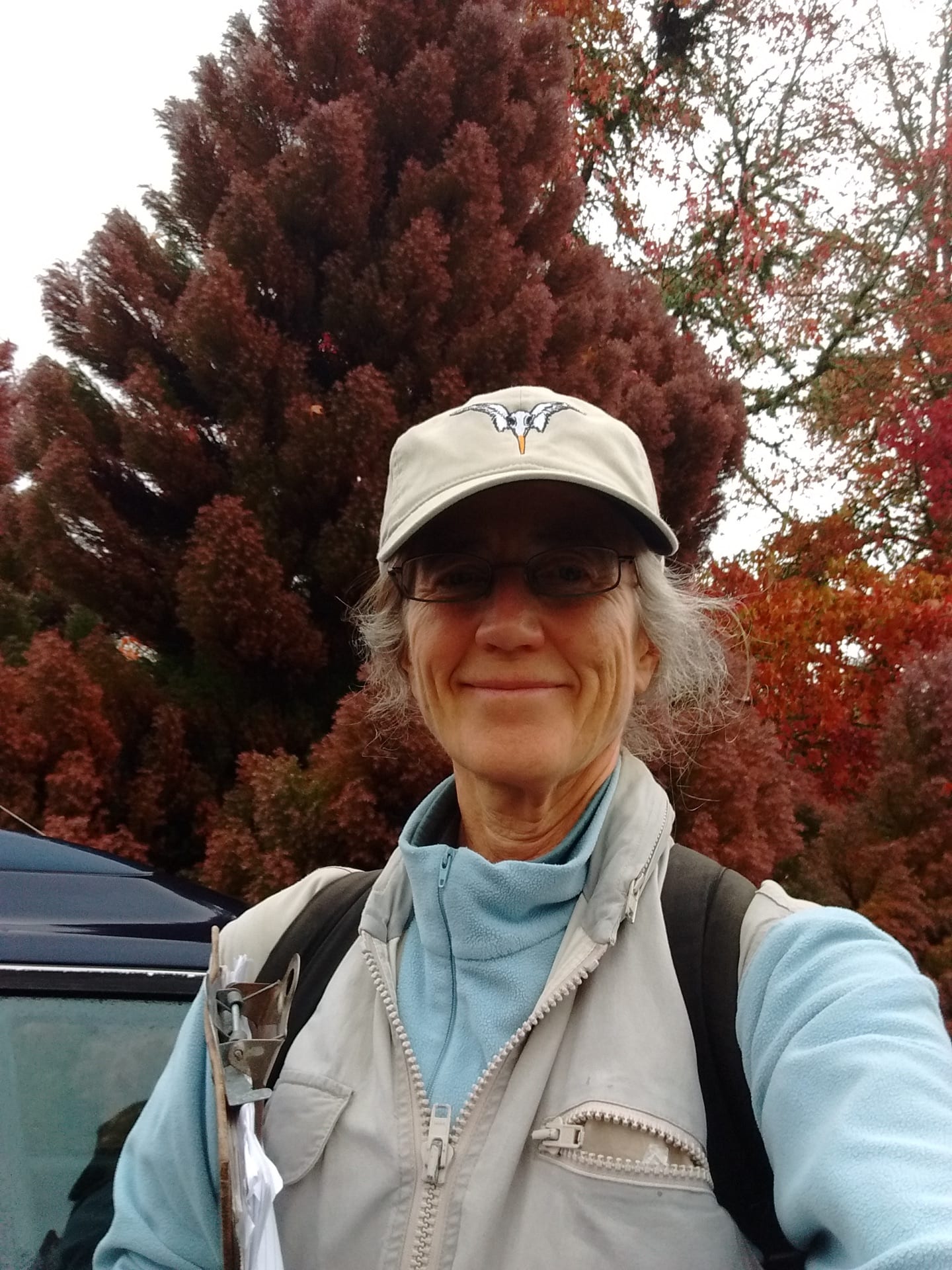 asking in Alaska and the Gulf were similar to the ones COASST is asking,” Williams says. “It shows why it’s so important to have background numbers in case of big mortality events.” And so in that way it makes sense that she started volunteering with COASST after she went to Agate Beach one day more than ten years ago and saw some dead birds marked with the ubiquitous COASST colored zip-ties. “We were just enjoying ourselves,” she says, “and there they were.” She contacted COASST and learned that the volunteer who had been responsible for Agate Beach was leaving. The beach was only about an hour from her home in Corvallis. “So I just picked it up,” she says.
asking in Alaska and the Gulf were similar to the ones COASST is asking,” Williams says. “It shows why it’s so important to have background numbers in case of big mortality events.” And so in that way it makes sense that she started volunteering with COASST after she went to Agate Beach one day more than ten years ago and saw some dead birds marked with the ubiquitous COASST colored zip-ties. “We were just enjoying ourselves,” she says, “and there they were.” She contacted COASST and learned that the volunteer who had been responsible for Agate Beach was leaving. The beach was only about an hour from her home in Corvallis. “So I just picked it up,” she says.
At the same time, and considering the breadth of her experiences with dead birds in some of their more soul-wringing circumstances, it might seem a little odd that in her spare time Williams would choose to watch for more dead birds, spending as much as five hours at a time meticulously searching for them. But that is not the case at all. “Whatever has happened in my life, no matter how intense some of the projects have been, I have always enjoyed having this work to do,” she says. COASST gets her outside, and she feels like she’s making a contribution, and that’s something she’ll always love. “I would go out to Agate Beach two or three times a month if I could,” she says.
by Eric Wagner
Allison DeKerlegand helps with the marine debris side of things. She studies environmental science and resource management, and did a study abroad in Australia, in North Queensland, near Cape Tribulation. Apparently its name is apt. “The beaches there have just as much debris as our local beaches,” she says.
Maddy Hoiland took a course in environmental studies and liked it, but she wanted to apply the things she was learning in it in the real world. She emailed Jackie Lindsey last spring, and has since helped with data entry and mailings.
Jess Quinn is a second-year student in the School of Aquatic and Fisheries Sciences. Her roommate was a COASST intern before she was, which was how she learned more about the program. She has what she describes as a “whiteboard enthusiasm” for population genetics research, but she also feels it is important to see and understand the natural world. (Not that these impulses are mutually exclusive, of course.)
These are just a few of the current crop of COASST interns who help to keep the program humming. Interns are vital to the COASST enterprise, and COASST has had over 250 since it began almost twenty years ago.
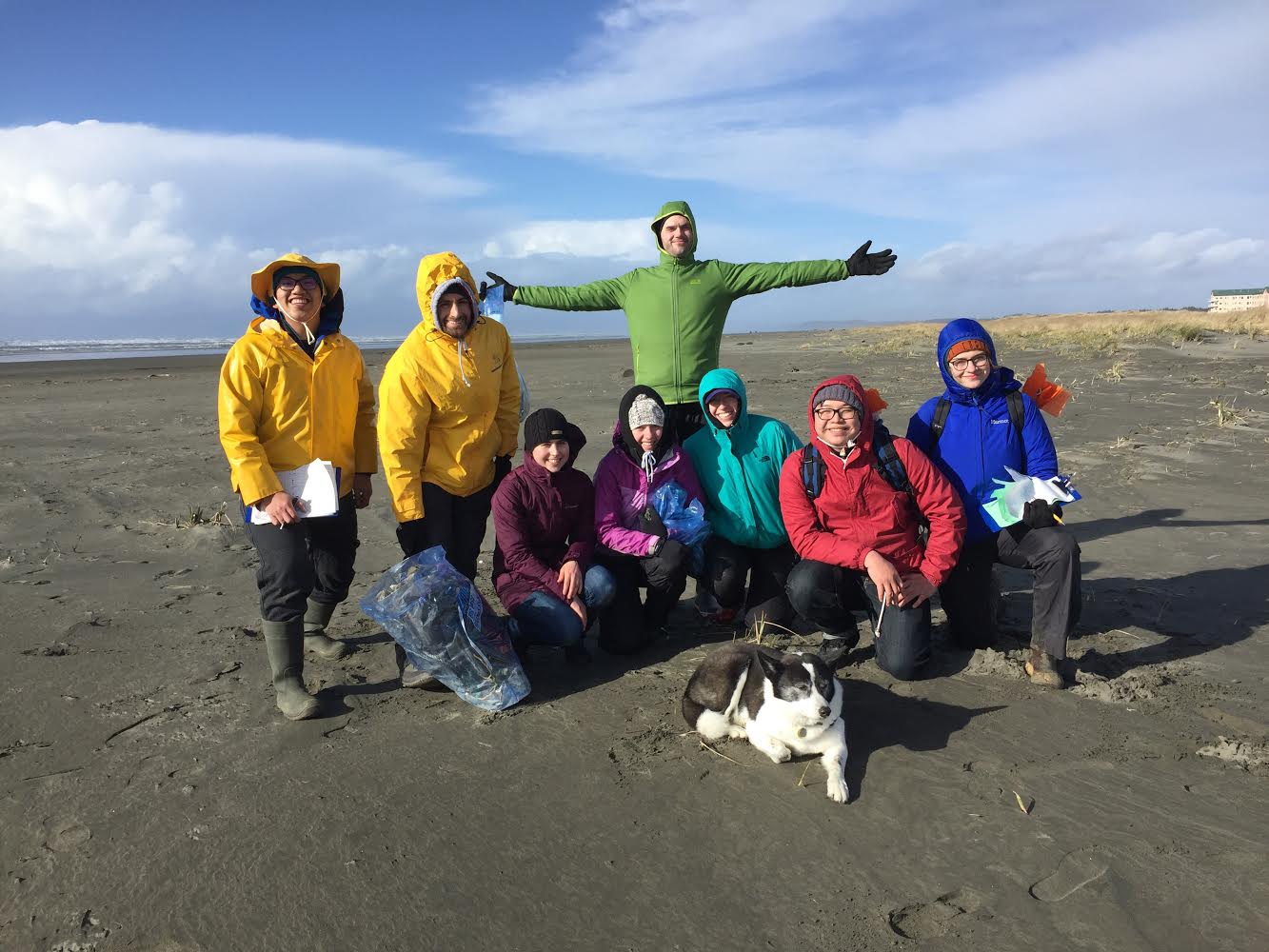
Left to right: Andrew, Andrew, Emily, Bailey, Tim, Jane, Justin, Abby. (COASST dog Freya, front and center). 2018 COASST intern field trip 2018.
Nowadays, all student interns start out in COASST as generalists, helping with data and participant questions, and crafting survey materials. They learn about every piece of the program, and begin to see how those parts come together as a whole. After a quarter or two they begin to focus more on their favorite aspects of COASST. Some stay with data entry, or help put together survey kits, and others lead outreach and email projects.
In the first quarter of their internship, students will spend about eight hours per week in the COASST office learning the ropes, but after that the commitment can be more flexible. “COASST couldn’t run without our interns, so it’s great for us,” says Jackie Lindsey, the Participant Coordinator. “And the students learn a lot, too, about data management and processing, about communicating science and engaging the public.”
Even if they do not stay in citizen science, former interns have found their COASST experience can help in unexpected ways. Chris Biggs, for example, was an intern about nine years ago. “Interning with COASST just sounded like an interesting opportunity that was different from a lot of the other internships that were available at the time,” he remembers. “I didn’t know much about citizen science, but was intrigued by it, and I thought I could learn more that way.”
Learn he did. Biggs helped with data entry from the seabirds surveys, he did some work on seabird ID quizzes, he represented COASST at the annual shorebird festival at Grays Harbor. “It was a lot of fun,” he says. He is now at the University of Texas at Austin, finishing his Ph.D. in fisheries ecology. (You might have heard of him—he is New York Times-famous.)
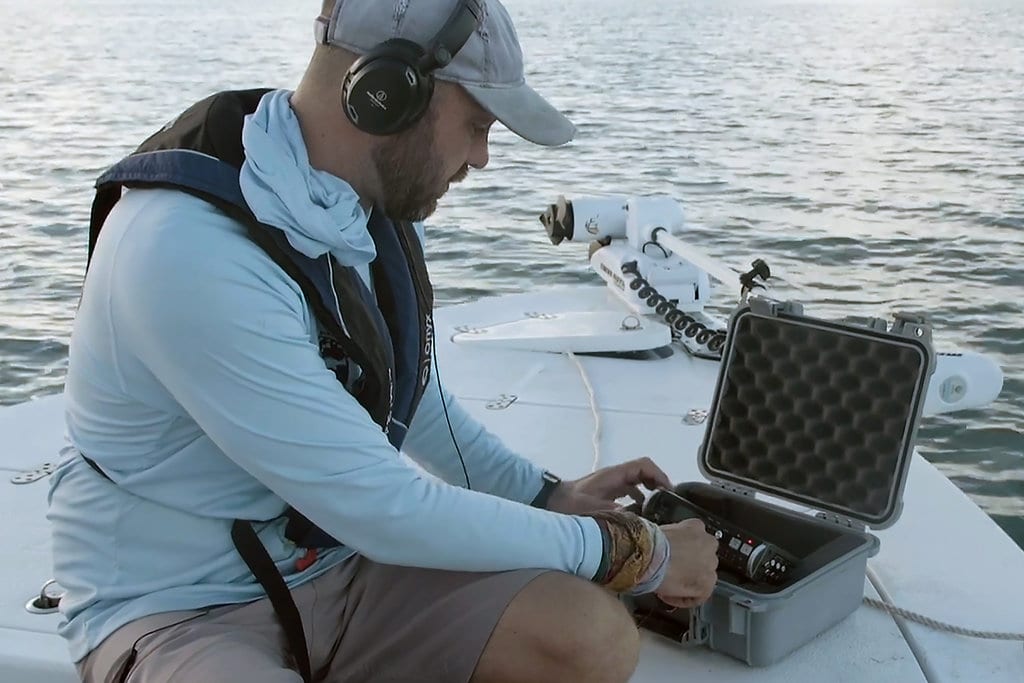
Chris Biggs conducting research on seatrout for his graduate program at the University of Texas at Austin.
Although his work has nothing to do with seabirds or marine debris—he studies fish spawning—Biggs says the experience definitely helped in other ways. Part of his research has him interacting with local recreational fishers, so he can get information on the reproductive status of the fish they are catching. “I learned a lot about working with the public and non-scientists,” he says. “These days, it’s important for scientists to know how to talk to people who might be interested in what you do but are not necessarily trained in that field. So yeah, in that way it was a big help.”
Goodbye 2018, you flew right by.
Before 2019 takes loft, let’s pause on the past twelve months in COASST.
Together, we accomplished A LOT!
Beached bird COASSTers completed 3,274 surveys, documenting 2,927 birds comprised of 94 different species. Common Murres are still the top find, making up 30% of birds reported, followed by Northern Fulmars (15.7%) , and Large Immature Gulls (11%).
First-ever records included a Red-footed Booby, Red Crossbill, and Burrowing Owl.
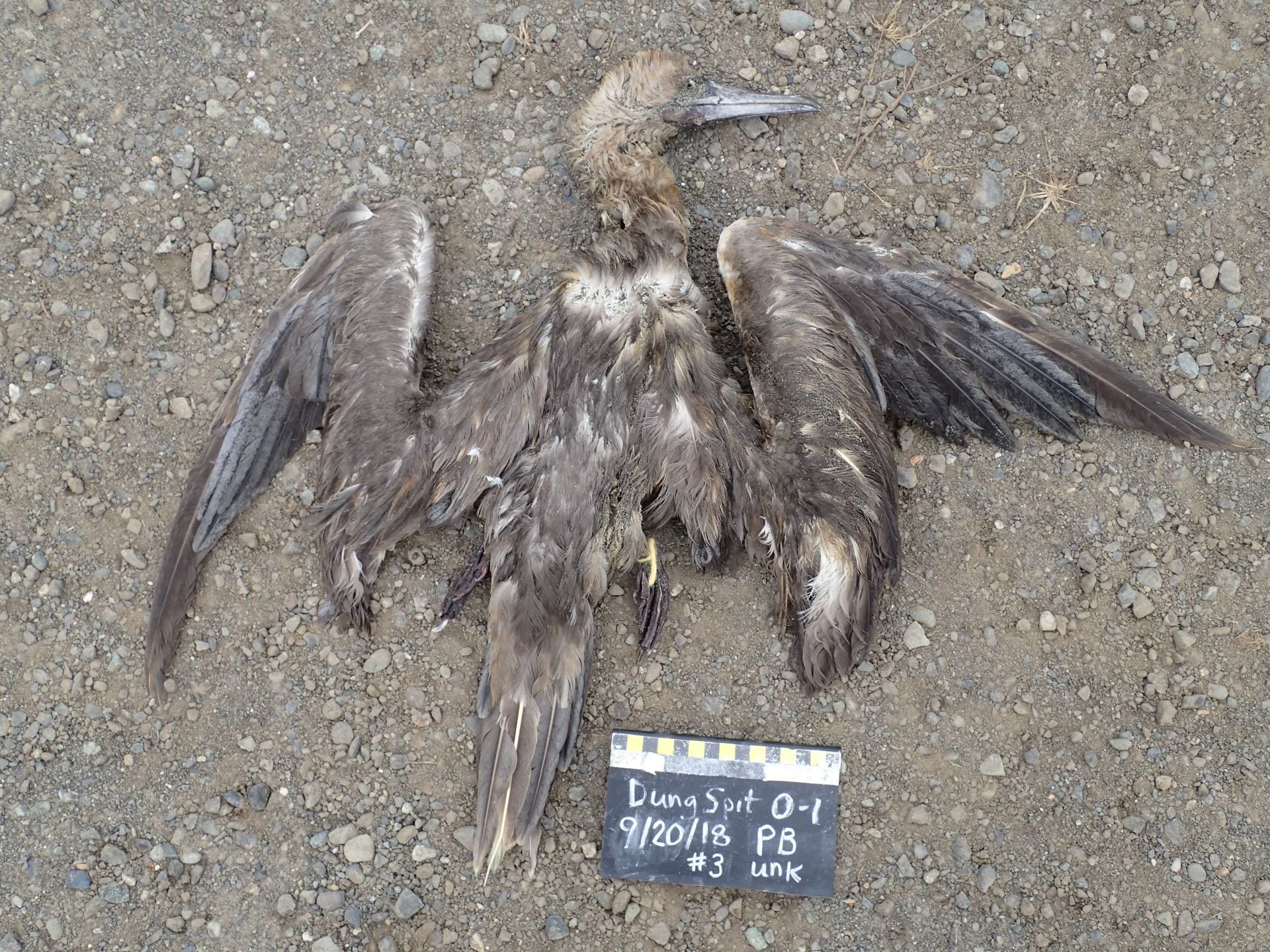
Among the beached birds encountered this year, this Red-footed Booby reported by Mary Sue and Elaine was a first.
Marine debris COASSTers completed 150 small debris, 224 medium debris, and 221 large debris surveys– characterizing 4,395 items!

Water bottles of brand “Nongfu Spring”, like this one found by Roger and John, are emerging as a top marine debris item encountered by COASSTers.
All told, COASSTers spent 5025 hours on the beach doing surveys. Add in travel, paperwork and data entry time, and over 10,000 hours were contributed to COASST. And we heard from many of you that you had fun doing it!

Ron inspired us to wonder: should we amend the COASST Cover Sheet to include participant entanglement?
What did all of those contributions make possible?
Back in the office…
We worked to translate survey data into results, and to share those results with audiences that included COASSTers, scientists, resource managers and the public. A few highlights:
In 2019, marine conditions varied greatly across the range of COASST. In the lower 48, conditions on the beach were more or less back to normal.
In the far north Pacific, Northern Bering and Chukchi Seas, sea surface temperatures continued to be warmer than normal, where we witnessed ongoing unusual mortality of seabird species. To assist with tracking these events, and in collaboration with agencies, communities and organizations throughout Alaska, we launched “Die-off Alert” — a method of reporting observations of die-offs where monthly surveys are not conducted, and a quarterly newsletter In The Wings.
A huge THANK YOU to all of the participants, partners, interns and funders who worked with us this year, and cheers to the year ahead!
In 2013, COASST got its first grant to expand to a whole new data collection protocol – marine debris. Following the tsunami of 2011 that resulted from the Tōhoku earthquake, this was a no brainer. But debris had been on the minds of many COASSTers well before the flotsam from Japan hit our coastlines. In fact, many COASSTers have always gone to the beach armed with a trash bag.
It’s definitely a nuisance, and can also be a health hazard for humans and wildlife alike, but could it also be science?
Could regular monitoring uncover patterns of trash on our beaches?
That’s what Hillary Burgess, the COASST Science Coordinator was brought on to figure out. And after years of development, input from more than 75 pilot testers, 30 interns, marine debris experts and the COASST staff and Advisory Board, we’ve not only got a viable program, we’re starting to “see” the patterns.
This is the first blog in a series revealing what Marine Debris COASSTers are finding. Not quite (!) as numerous as COASST Beached Birds, and certainly not as long in the tooth…, our marine debris program is off to a fantastic start. As of mid-November here are the numbers:
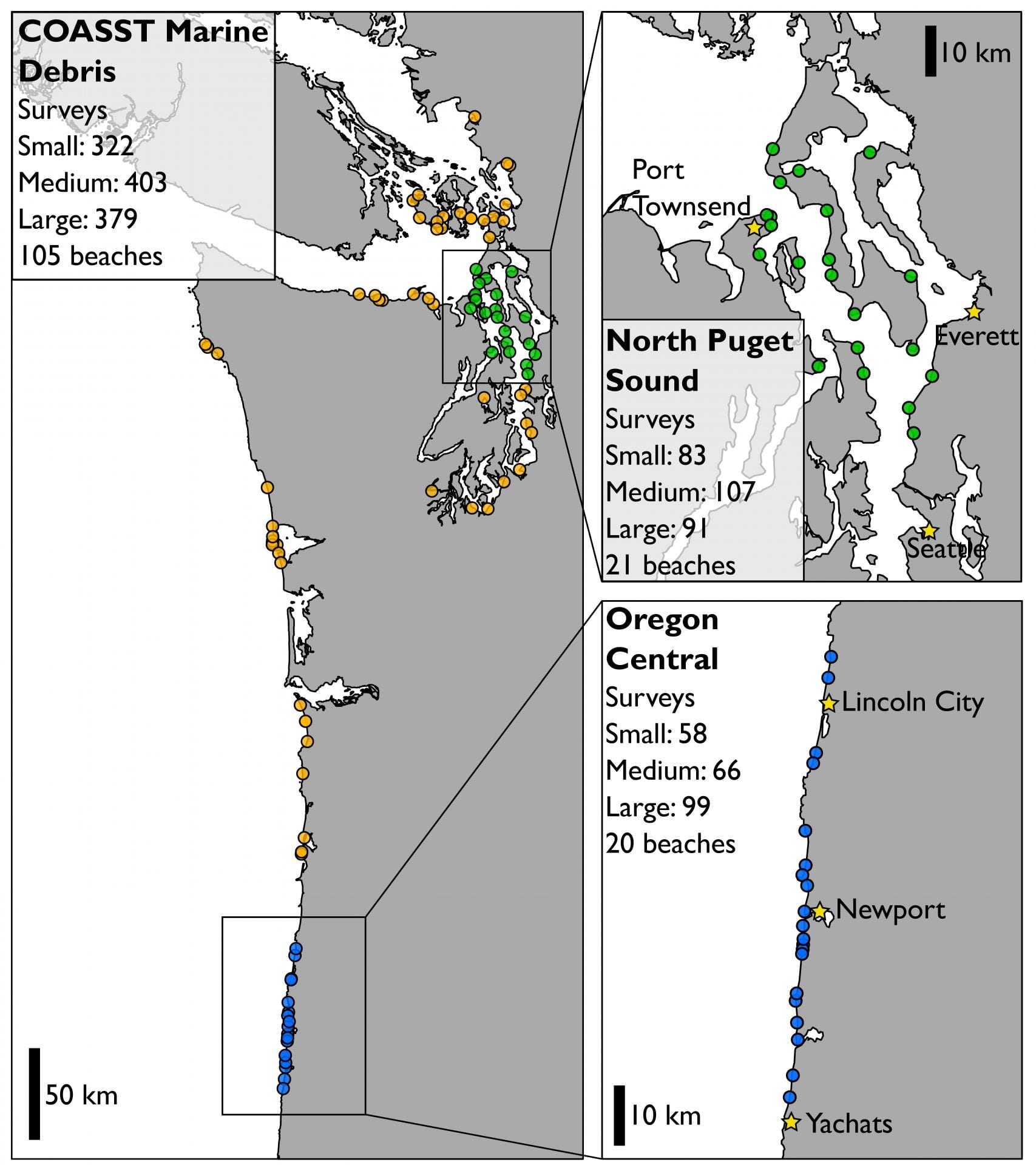
COASST marine debris survey sites have been monitored most consistently for the longest time in North Puget Sound and Central Oregon.
Although COASST marine debris data comes from throughout Washington and Oregon, and even a few test sites in Alaska, we’re confining our analysis for the moment to two regions with a multi-year, multi-beach sample size, and some pretty interesting differences: the outer coast beaches of Central Oregon, and the protected waters of North Puget Sound.
First, let’s step back to some basics. When considering how many beached birds COASSTers find, we use a measure we call “encounter rate” or the number of carcasses a COASSTer might find per kilometer of beach surveyed. Encounter rate treats all beaches – wide ones and narrow ones – the same. And when COASSTers search for carcasses, they comb the entire beach – from the waterline to the vegetation.
Debris is different.
First, we separate debris into size classes:
Second, we report the amount of debris as a function of the area searched. So, not per kilometer, but per 10,000 meters squared (10,000m2), or 100m2 to ensure that the values we present are meaningful. To put these areas into perspective, 10,000m2 is approximately the area of two football fields and 100m2 is one quarter the size of a basketball court.
Third, we take account of the differences in the amount of debris in five (5) different beach zones:
Not surprisingly, small debris – the count of small debris (per 10,000m2) is much higher than that of medium debris, which is more numerous than large debris. And this pattern holds for the outer coast, and for Puget Sound. However, there is a lot more small debris on the outer coast!
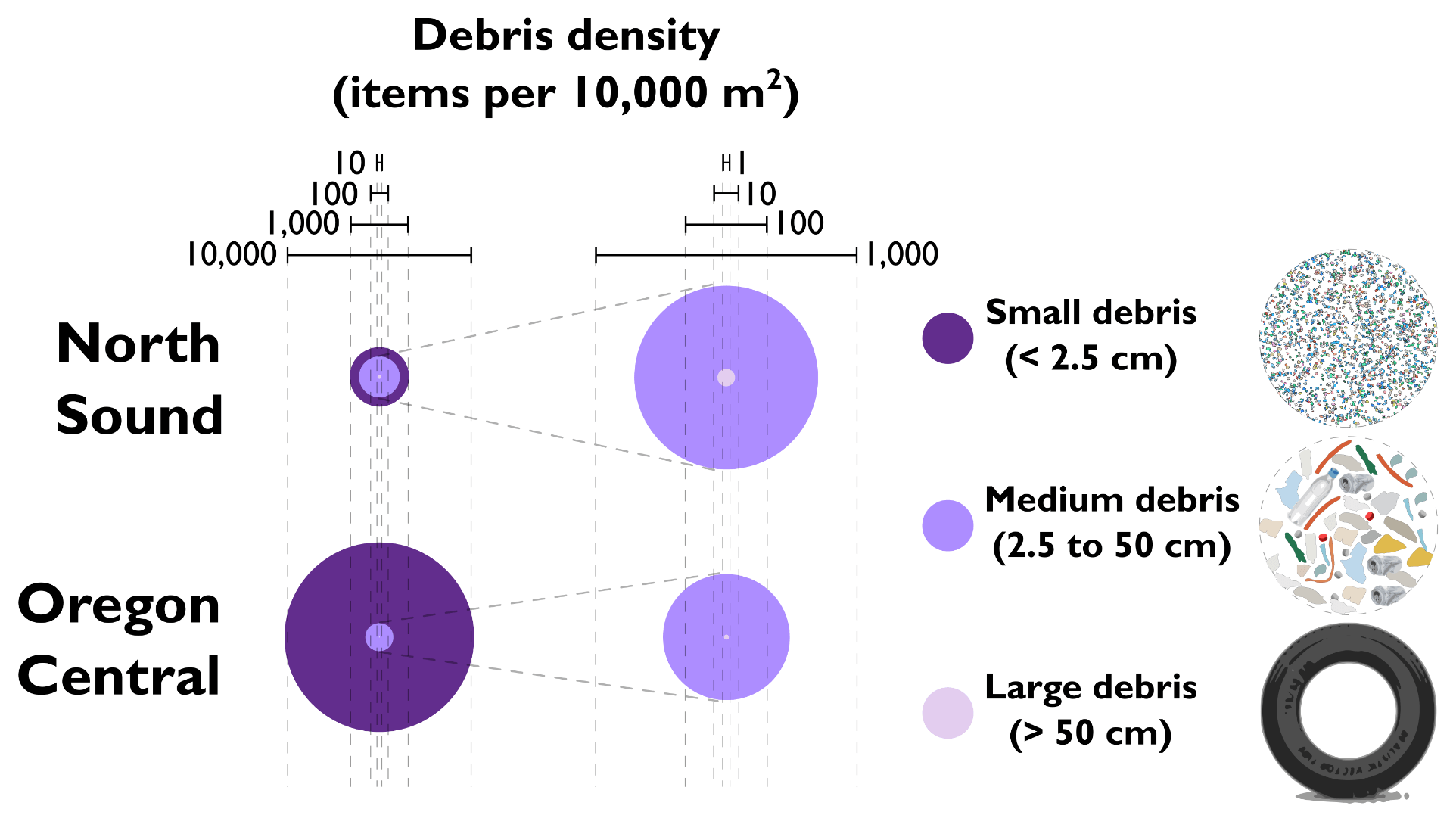
The bubbles on the left illustrate debris density, or the estimated count of pieces – by size – you might find on average – from the waterline to the vegetation, scaled to 10,000m2. Small debris (darkest purple) is very abundant, and especially in Central Oregon, where you could find upwards of 10,000 pieces in a 100 meter by 100 meter area of beach! In the middle is a blow-up of the medium and large debris pattern (because those numbers are dwarfed by small debris we had to separate them out and blow them up). To the right is the color code, and a schematic of the relative sizes and types.
And the reverse is true of medium debris – inside waters have a higher density than beaches along the outer coast. The pattern is similar, albeit less pronounced, for large debris.
Where is all of that small debris? Mostly in the wrack, at least in Central Oregon. Conversely, along these outside waters beaches, medium and large debris are primarily found in the vegetation, and secondarily in the wood zone. (Note that small debris are only sampled in the wrack, bare and wood zones).
North Puget Sound COASSTers find similarities, and differences. Small debris is also most numerous in the wrack zone, but the wood zone has just under 90% of that peak density, and the bare zone sports just under half of peak density. Medium and large debris are primarily found in the wood zone, but density in the vegetation falls off quickly, in contrast to the vegetation zone on outer coast beaches.
We’ll compare a kilometer long “typical” beach in North Puget Sound to one along the coast of Central Oregon averaged over the year. You would be lucky to find a single bird in your North Puget Sound beach survey, but you’d likely find 5-10 large pieces of debris, 1,000 medium pieces, and a whopping 2,500 small pieces.
Seems like a lot, until you travel to the coast of Oregon. Here you would find on 3-5 birds averaged over the year, 3-4 large pieces of debris, 2,500 medium pieces, and a stupendous 100,000 pieces of small debris.
The humongous medium and especially small debris numbers are why COASST subsamples the beach. Otherwise, Sisyphus would long since have been successful in rolling his rock up the hill before any outercoast COASSTer finished picking up all of the small debris! A somber note, of course, is that this is what we face along our beaches and in our ocean, and – you guessed it – it’s almost all plastic, with 70% of medium debris and 87% of small debris items being plastic.
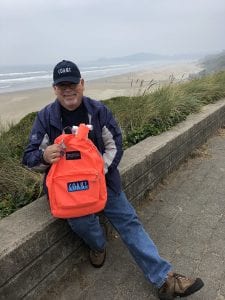
When a person spends a lot of time searching for things that have washed in with the tide, and those things are often dead, certain metaphors tend to offer themselves up. One that has become semi-regularly associated with COASST is CSI. (That’s Crime Scene Investigative unit, for those of you who, like me, do not regularly watch the show.) COASST has been variously described, often by COASSTers themselves, as “CSI for dead birds,” or “CSI for garbage.”
For Mark Miranda, the metaphor hits a little closer to home than it might for most COASST volunteers. Where many of them have a background in biology and have to learn the finer points of ecological forensics, Miranda’s expertise comes from the other direction. “In junior high school I dissected a frog, and that’s about it as far as biology training goes,” he says. “But crime scene training, I’ve had a lot of that over the years, just doing search warrants and things like that.”
Miranda recently retired as the Chief of Police for the Newport Police Department, after a career in law enforcement that spanned forty-six years. He was born and raised in the San Francisco Bay area, in California, and first joined the police department in Tucson, Arizona. Then, in 1981, he and his wife moved to Newport, Oregon, and there they stayed. He had heard about COASST several years before he became a volunteer, and while he was intrigued by it, he just didn’t have the time at first. But once he retired, he was looking for things to do, and he saw a flier for a training session at the Hatfield Marine Science Center. He went and signed up to search for marine debris. He now surveys Seal Rock beach, a few miles north of Newport. The beach is quiet and secluded, and on a typical Oregon summer day, surveys are quite pleasant. “I pick up after people, and I pick up after the ocean,” Miranda says.
So is surveying for marine debris really the same as working a crime scene? “The techniques are basically the same,” Miranda allows. “You see something, you photograph it, you measure it, you collect it, try to identify what the object it is. So it is kind of what I would do in my job.” As for whether he has ever thought of adding beached birds to his surveys, which would seem a natural extension from his old line of work, here Miranda demurs. “I’ve been dealing with dead things all my life, so it’s nice not to need to anymore,” he says.
The debris can more than stand up in its own right ecologically. Miranda likes that he is adding a small piece to a potentially enormous puzzle, and he knows from experience how small puzzle pieces can be the key to the whole thing. Also, scrutinizing debris that may have been drifting for months or even years presents its own special challenges, its own mysteries. “Most of what I find is pretty weather-beaten, just broken bits or plastic, things like that,” Miranda says. “So I’m never too sure what it was.”
 In 2014, Julia Parrish, COASST’s executive director, was looking to expand the program farther down into northern California, in the Mendocino area. An Audubon chapter there was discussing the possibility—they liked it very much—and so one of their more involved volunteers was asked to meet with Julia when she came to visit.
In 2014, Julia Parrish, COASST’s executive director, was looking to expand the program farther down into northern California, in the Mendocino area. An Audubon chapter there was discussing the possibility—they liked it very much—and so one of their more involved volunteers was asked to meet with Julia when she came to visit.
“That was how I met her,” says Charlene McAllister, now a COASST volunteer, “and then it just kind of took off.”
A nurse by profession, Charlene had been involved with birds in a variety of ways for years. There were the weekly shorebird surveys (“I’ve been doing those for about seven years”), the black oystercatcher breeding surveys, the Christmas bird counts. So, really, what was one more bird-centered pursuit? Granted, it was walking the beach and looking for dead birds, but that was hardly dissuasive.
“Being a nurse, I’ve been around death before,” Charlene says. “I know that death is a part of life.” The question for her hinged on knowing to the greatest extent possible whether the dead birds were normal, or indicators that something big and abnormal was afoot. “That’s what makes finding out how the birds died so important,” she says.
Indeed, Charlene has lived on the Pacific coast long enough to know it is in the midst of some big changes. She grew up in Humboldt County, and went to high school in Crescent City, about an hour north of where she surveys now. Then as now, she spent a lot of time on the ocean, and could often be found at the beach at least three days a week. “I was a real tidepooler,” she says.
 Charlene has surveyed a few beaches in her four years with COASST, but the one she has done most consistently is, as she says, a “very, very popular beach” called Virgin Creek. The section is named for the creek that emerges from the woods and sometimes flows all the way to the ocean, or sometimes does not, depending on the season. A typical survey has her meeting up with her partner, and then they gossip all the way down to the water. They mark off their zones, and then start walking. As a pair they sometimes dawdle a bit, take in the living birds, enjoy the sand. “You’re on the beach, after all,” she says.
Charlene has surveyed a few beaches in her four years with COASST, but the one she has done most consistently is, as she says, a “very, very popular beach” called Virgin Creek. The section is named for the creek that emerges from the woods and sometimes flows all the way to the ocean, or sometimes does not, depending on the season. A typical survey has her meeting up with her partner, and then they gossip all the way down to the water. They mark off their zones, and then start walking. As a pair they sometimes dawdle a bit, take in the living birds, enjoy the sand. “You’re on the beach, after all,” she says.
But that does not distract her from her larger purpose. “I think citizen science is really important,” Charlene says. Given the size of the world, the challenges facing it, there is simply no way for scientists themselves to collect everything in this day and age. (“Even with interns,” Charlene adds.) But what is really important is that COASST is opening the eyes of people who might not have thought that going out to the beach and handling dead birds was something they might want to do. Around Mendocino, there is a volunteer who is a first grade teacher, and she is so excited she can share the things she learns on the beach with her students. And there are all the people who stop to see what she is doing, and when she tells them, ask her why.
“It’s critical,” Charlene says, “to use citizen science not just to gather data, but also to reach a larger audience.”
Come late fall into early winter, Northern Fulmars start to appear on Pacific Northwest outer coast beaches. The #2 species in COASST, this denizen of Alaska is virtually absent from the Lower 48 during the spring-summer breeding season. And that’s because they are busy on colonies from Gareloi Island in the Western Aleutian Islands to St. Matthew Island in the northern Bering Sea.
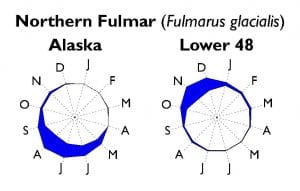
Fully ~1,250,000 are thought to breed in Alaska, mostly on offshore islands with steep cliffs where they scrape out a shallow depression to lay their eggs. The pulse of fulmar on Alaska beaches is actually during the breeding season! But once that season has ended, adults and young-of-the year alike take off for points south.
Well, at least that’s the usual pattern.
In the 2017-18 winter, fulmars were notably absent from Lower 48 beaches. What’s weirder, they suddenly appeared in late winter-spring. In late April, usually the quietest time of year for COASSTers, Jane and Makenzie found 14 Northern Fulmars on their survey of Nye South near Newport in Oregon. Charlie, COASST’s stalwart verifier, noted that across Oregon beaches, not only were there more fulmars than usual, but many of them were light morph birds.
Morph? What’s a morph?
At first glance, fulmars are boring-looking birds. No difference in plumage between adults and immatures, breeders and nonbreeders, or males and females. But the traditional plumage differences in birds just doesn’t tell the story of fulmars.
These birds have two different plumage patterns, which appear to map onto where they breed. So called “dark morph” birds, resembling their Tubenose relatives the shearwaters (but note the stocky, pale bill of the fulmars!), principally breed in southern Alaska. Light morph birds, resembling gulls (but note the telltale plates on their Tubenose bill versus the smooth, featureless bill of the gulls), breed farther north, in the Bering, Chukchi and Arctic. What’s cool about this difference is that COASST can get a sense of where fulmars are coming from based on their plumage.
Most Lower 48 COASSTers find the dark morph. Light morph birds do wash up where they breed during the breeding season, and then migrate down the “other side” of the ocean towards Japan, Taiwan and Korea. But not in 2017-18.
In fact, turns out light morphs have graced Lower 48 beaches in previous years, most notably in 2008 and 2009. Some years – like 2009 and 2018 – have no fulmars during the usual peak, but display a peak in the following spring, whereas other years – like 2006 and 2008 – have a double pulse: once when they’re supposed to arrive, and a second spring peak. Guess which morph arrives in the spring … in both 2008 and 2018, the ratio of light morph fulmars was much higher than usual. Of course the vast majority of fulmars found on Lower 48 beaches are dark morphs, occasionally loads of them, as was the case in 2003/2004.
Since COASST discovered this “light-spring” pattern, we’ve been wondering about it. Who are these guys? And where are they coming from? Given the spring migration timing, it would seem that these birds are actually on the way back north to begin the breeding cycle. So, do light morphs occasionally migrate up the eastern side of the ocean? Or do they always do that, and only sometimes wash ashore? And would that be a weather signal? An ocean circulation signal? A climate signal? Or… We remain mystified!
What’s your prediction as we head into the 2019 fulmar season: dark morphs in winter, or light morphs in spring?